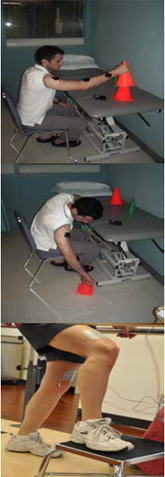What is FES?

Examples of FES
FES is a technique that uses electrical current to cause a muscle to contract. The body naturally uses electrical currents to make muscles move. Normally, when a part of the body needs to move, the brain sends electrical signals through the nervous system. The nerves, acting like electrical wires, send these signals to the muscles, telling them to contract. This contraction causes the body part to move.
After a stroke, some of these electrical signals don’t work as well as they should. FES allows muscles that have been paralyzed or partially paralyzed by stroke to move again. When using FES as a treatment after a stroke, an electrical current is applied to the skin over a nerve, or over the bulk of a muscle, which causes the muscle to contract. If the peripheral nerves are damaged, it may not work.
FES also works for:
- issues with walking
- hemiplegic shoulder with shoulder subluxation
- upper extremity (shoulder, elbow, wrist and hand) function for grasp and reach
FES isn’t for people who have uncontrolled epilepsy, poor skin condition, have a cancerous lesion on the area to be treated, are oversensitive to the electrical stimulation, or have a pacemaker. Speak with your therapist if you think FES may be a treatment choice for you.
Are there different kinds of FES?
Yes. You might see it also called functional neuromuscular stimulation and electrical stimulation. While the names are different, they all have the same goal, which is to stimulate muscle contraction. This may lead to more function, strength, and movement and less pain and spasticity (muscle tightness).
What can I expect?
Small square stickers (electrodes) are placed on the skin over the centre of a muscle. Wires connect the electrodes to a stimulator, a small machine that makes the current.
The stimulation is usually started at a very low level, causing a tingling "pins and needles" feeling on the skin. The current is then slowly increased until it’s strong enough to make the muscle contract. This level (the smallest current needed to make the muscle contract) will be used for the treatment. It’s important that you actively try to do functional tasks during FES (e.g., grasping and releasing an object).
Although some people find the treatment uncomfortable, most tolerate it quite well. Treatment times may vary. However, the time is usually divided into a few sessions a day. FES treatments are usually done for 30 to 45 minutes.
Are there any side effects or risks?
Some people may find that certain types of electrical stimulations are irritating, but this is easily fixed by changing the level of the current. The electrodes can irritate the skin, but this doesn’t happen very often. Using non-latex hypoallergenic electrodes can often solve this problem.
After the treatment, there may be pink marks left on the skin where the electrodes were placed, but these are usually gone within an hour. Although very rare, FES can increase muscle tightness.
How many treatments do I need?
There’s no set limit. Some people use FES for many years. To get the most benefits after stroke, a trial of FES may done (for example, for a month) to see if FES will help you.
Can I continue FES at home?
Yes, you can. If you have a home stimulator, family or friends will be shown how to help with treatments. NOTE: Make sure you speak with your therapist or doctor about the model of machine you use. They’re not all the same.
How much does it cost? Does insurance pay for it?
Although the cost varies, some aren’t too expensive. Renting or leasing one will cost about the same as 1 or 2 clinic visits. Check with your insurance company to see if they will pay for renting or buying the machine. There is no cost for treatment with FES while in AHS care.
Where can I learn more about FES?
Adapted with permission from Author: Marc-André Roy, MSc. And Kristin Musselman, PhD
